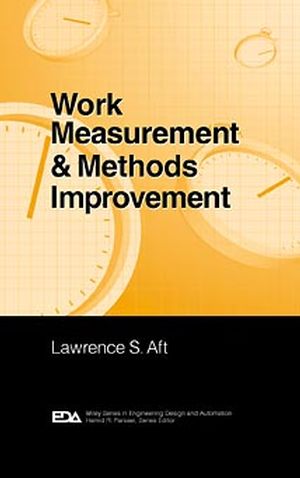Work Measurement and Methods ImprovementISBN: 978-0-471-37089-5
Hardcover
464 pages
February 2000
 This is a Print-on-Demand title. It will be printed specifically to fill your order. Please allow an additional 10-15 days delivery time. The book is not returnable.
|
||||||
I Productivity – An Introduction 1
1 Introduction 3
Anecdotes 4
Analysis 8
Why is Productivity a Problem in the United States 10
Ways to Improve Productivity 12
A Role for Industrial Engineering 15
What about Japan 17
Where to From Here? 20
2 Methods Analysis 22
Objectives 22
Introduction 22
The Scientific Method 24
Summary 30
II work Analysis 31
3 Graphical Productivity Analysis 33
Objective 33
Introduction 33
Graphical Analysis Tools 34
Summary 85
Review Questions 86
Practice Exercises 86
4 Work Methods Improvement 105
Objectives 105
Introduction 105
Methods Improvement Defined 106
The Best Method 107
Therblig Analysis 109
Principles of Motion Economy 117
Man vs. Machine 125
Selling the Solution 132
Summary 138
Review Questions 141
Practice Exercise 141
III Measuring Productivity 145
5 Time Study 147
Objectives 147
Introduction 147
Purpose of Work Measurement Studies 148
Rating Job Performance 150
PFD Allowances 151
Calculating the Standard Time 152
Conducting a Time Study 153
Elemental Analysis 160
Determining Number of Cycles to Time 169
Potential Data Recording Difficulties 180
Data Analysis 183
Interpretation of Results 185
Special Cases 189
Summary 203
Review Questions 203
Practice Exercises 204
6 Standard Data Systems 209
Objectives 209
Introduction 209
The Purpose of Standard Data Systems 210
Constructing Standard Data Systems 211
Methodology for Developing Standard Data Systems 226
Advantages of Standard Data Systems 241
Limitations of Standard Data Systems 241
Summary 244
Appendix – Correlation and Regression Analysis 244
Review Questions 249
Practice Exercises 250
7 Predetermined Time Systems 253
Objectives 253
Introductions 253
The Purpose of Predetermined Time Standards 254
Use of Predetermined Time Systems 255
Application of a Hypothetical Predetermined Time System – AFTWAYS 256
Advantages of Predetermined Time Systems 278
Selecting a Predetermined Time System 278
Limitations of Predetermined Time Systems 279
Examples of Existing Predetermined Time Systems 279
Summary 298
Review Questions 298
Practice Exercise 298
8 Work Sampling 299
Objectives 299
Introduction 299
Definition of Work Sampling 300
Conducting a Study 305
Advantages of Work Sampling 319
Limitations of Work Sampling 320
Summary 322
Sample Size Determination 323
Review Questions 324
Practice Exercises 324
9 Physiological Work Measurement 330
Objectives 330
Introduction 330
Measuring Physiological Work 331
Uses of Physiological Work Measurements 335
Implications for Productivity 337
Summary 338
Review Questions 339
10 Labor Reporting 340
Introduction 340
Constructing a Labor Variance Report 341
Variation 343
Labor Efficiency 348
Using Labor Reporting and Work Sampling to Manage Staffing Levels 351
Conclusion 359
Practice Exercises 360
IV Improving Productivity 363
11 Introduction to Ergonomics 365
Objectives 365
Introduction 365
Approach to Human Factors Design 366
Work Design Considerations 373
Industrial Applications of Ergonomics 380
Summary 382
Partial Listing of Design Guidebooks 383
Review Questions 384
12 Incentives to Increase Productivity 385
Objectives 385
Introduction 385
Incentive System Design 388
Types of Incentive Plans 390
The Scanlon Plan 402
The Lincoln electric Plan 404
Summary 408
Review Questions 408
Practice Exercises 409
13 Alternative Methods for Increasing Productivity 412
Objectives 412
Introduction 412
Quality of Work Life 413
Quality Control Circles 419
Work Measurement and Continuous Improvement 429
Alternative Work Pattern – Flextime 433
Other Motivational Approaches to Productivity Improvement 434
Summary 437
Review Questions 438
Bibliography 439
Index 449



